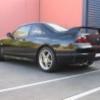Announcements
-
Similar Content
-
Latest Posts
-
You could do that by all means. but yer it shouldnt be hard to get a VR30 to 400hp with an ECUtek on stock everything.
-
That's true. However, this problem has started since the tuning. First time with the return journey from the tuning. But yes, the pipe was clogged with dirt and rust. That was certainly due to age
-
By Dose Pipe Sutututu · Posted
Great info @tidi0x Will definitely be handy for others and maybe me if I decide to keep the shit box H pattern. -
Bumping this up one last time.... I wanted to follow up on the clutch slave issue. I realized that what the issue comes down to is the pocket is flat milled, and the cylinder does not want rest flat. So in order to mount it correctly you will need to make a spacer for the fingers so the cylinder is floating. I took two plates of aluminum, drilled some holes and was good. I did still need to make the relief cuts in the bell housing, as even with the spacer the bleed section still interferes. The OE bell housing the mounting holes are raised from the housing.
-
By robbo_rb180 · Posted
If the event in USA goes ahead will be interesting as it seems the rules will get more cars over here. Apparently the track is laguna seca too. Yeah s15, if I get a the lower dash trims, centre console and change front cross member to standard LCA position will fit clubsprint. See how rules are as i would rather do complete widebody than a bolt on flare to run the 295 with proper clearance.
-









Recommended Posts
Create an account or sign in to comment
You need to be a member in order to leave a comment
Create an account
Sign up for a new account in our community. It's easy!
Register a new accountSign in
Already have an account? Sign in here.
Sign In Now